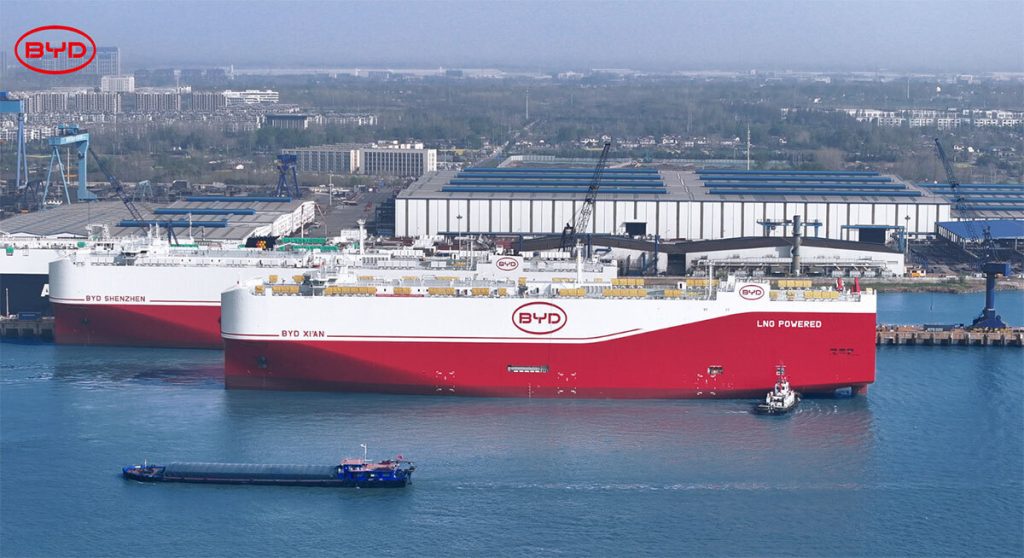While BYD has made waves in the electric vehicle (EV) industry, with its rapid growth and innovation, the company has just unveiled an exciting new venture that’s not related to EVs at all. Instead of focusing solely on cars, the Chinese automaker has taken a big step into the maritime industry with the launch of its massive new ship, the Xi’an, a state-of-the-art transport vessel.
BYD’s Bold Move into Maritime Transport
On April 2, BYD revealed the Xi’an, a colossal new roll-on/roll-off (RoRo) ship designed to carry vehicles across the globe. This move marks the company’s expansion into shipping, as it plans to significantly boost its transportation capacity for vehicles. Alongside the Xi’an, BYD also introduced the Shenzhen, touted as the world’s largest RoRo vessel, capable of carrying a whopping 9,200 vehicles. This is a major leap for a company traditionally known for its electric vehicles and battery technology, reflecting BYD’s growing ambition to diversify its operations.
While the exact capacity of the Xi’an hasn’t been disclosed, images of the Xi’an and the Shenzhen together suggest that these ships are part of an even bigger, more extensive plan. Both ships symbolize BYD’s strategy to enhance its global presence, expanding not just in the EV market but also in logistical capabilities.
A Growing Maritime Fleet
The Xi’an is the sixth ship in BYD‘s growing maritime fleet, and it’s just one of several vessels designed to transport vehicles efficiently. The company’s first maritime vessel, the Explorer No. 1, entered service in January 2024. This ship, which has a capacity of 7,000 vehicles, was leased out to a third-party operator. The Hefei, BYD’s first ship that the company owns, also has a 7,000-vehicle capacity and debuted in early 2024, delivering a load of 5,000 electric vehicles across Europe.
In October 2024, the Changzhou joined the fleet, with another 7,000-vehicle capacity. It made its inaugural journey in December 2024, transporting another significant shipment of electric vehicles to Europe. These efforts highlight BYD’s growing capability not just in making vehicles but in delivering them worldwide.
The Shenzhen now holds the record as the largest car transporter ship in the world, with a 9,200-vehicle capacity. It was completed in January, and its delivery represents BYD’s continuous push to improve its global logistics capabilities. The Changsha, another new addition to the fleet, also boasts the same capacity as the Shenzhen, completing the company’s impressive maritime expansion.

Expanding Beyond the EV Market
BYD’s move into maritime transport comes at a time when the company is ramping up its global expansion. After surpassing Tesla in global EV sales for two consecutive quarters, BYD is pushing forward with its global sales targets. According to Wang Chuanfu, CEO of BYD, the company aims to sell 5.5 million units by 2025, marking a nearly 29% increase over the 4.27 million vehicles sold in 2024.
What’s even more impressive is the company’s focus on expanding sales outside of China, with a goal of reaching 800,000 vehicles sold internationally by 2025. This represents an astonishing 92% increase from the 417,000 vehicles sold abroad in 2024. The addition of a major shipping fleet for vehicle transportation will undoubtedly play a key role in meeting these ambitious goals.
A Strategy for the Future
In response to slowing domestic growth in China, BYD is intensifying its global efforts to expand its market presence. The introduction of these large-scale shipping vessels is just one part of a broader strategy to streamline and enhance the distribution of its electric vehicles across the world. BYD’s ability to integrate innovative transportation solutions like the Xi’an and Shenzhen into its operations will give it a competitive edge in delivering vehicles to new markets efficiently.
This major new project showcases BYD’s ambition to become a dominant player in both the automotive and maritime industries. As the company continues to innovate and expand its operations, it will likely become even more central to the global shift towards sustainable transport—whether that’s on land or at sea.



